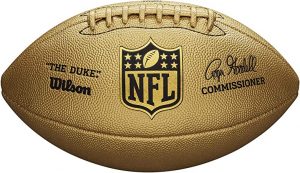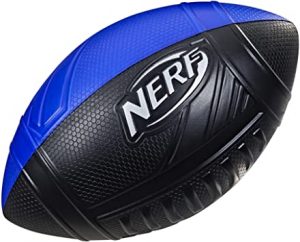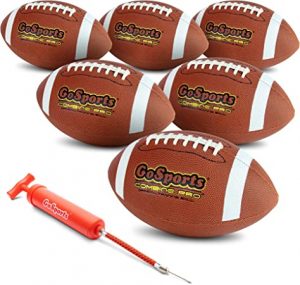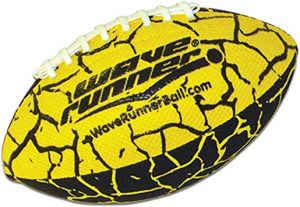The Best Footballs

Our Review Process
Don't Waste Your Money is focused on helping you make the best purchasing decision. Our team of experts spends hundreds of hours analyzing, testing, and researching products so you don't have to. Learn more.
Our Picks For The Top Footballs
- 1. Franklin Sports Weather Resistant Rubber Junior Football
- 2. Wilson NFL Authentic The Duke Football
- 3. Nerf Pro Grip Foam Football
- 4. GoSports Combine Football, 6-Pack
- 5. Wave Runner Waterproof Football
- 6. GlowCity Glow-In-The-Dark Youth Football
- 7. XEDGE Composite Leather Football
- 8. Nike Vapor Faux Leather Football
This highly durable blue-and-white football can stand plenty of wear and tear from any surface from grass to concrete. It has a deep-pebble grip so it’s easy to throw and catch. The ball is weather resistant and sized for young players.
Highly DurableThis youth-sized football can stand plenty of wear and tear.
This unique composite Wilson football comes in a regular brown or metallic finish that gives it its tacky feel and natural shine. The high-quality ball is great for collectors — it's an official size and features an NFL-inspired inscription.
Unique LookThis pro-style composite football comes in a metallic finish.
This versatile foam football toy can be used for outdoor and indoor play. It is made from foam and is easy to catch and throw, so it's perfect for casual games with kids or adults. Use it to practice catches and spiral passes.
Versatile OptionThis Nerf foam football can be used for outdoor and indoor play.
This football value set includes six regulation-size composite balls as well as a ball pump and a mesh carrying bag. The heavy-duty standard-size balls have an all-weather design and are perfect for high-school students and college players.
Value SetThis pack comes with six composite balls, a pump and a bag.
Buying Guide
Football, arguably America’s favorite pastime, is a popular sport across the country whether you’re watching or playing. And for adults and children who play, the game (as with any open-air sport) is a great way to get active, work on your athletic skills and get some fresh air.

Tackle football does require some specialized equipment, though. The most basic item, of course, is the elongated prolate spheroid ball.
First, it’s important to have a basic understanding of what the construction of the ball looks like. An outer layer is typically made from four panels of leather or synthetic leather, sewn together. Underneath that there is a middle layer (or sometimes layers) made from a lining material. At the core, a final layer is made from a synthetic, often butyl rubber air bladder.

Now that you know what a ball is, you can look at different options. Should you go with a real leather or synthetic leather surface? Leather is the popular, high-quality choice when it comes to professional game balls or high school and collegiate game balls. This material is highly durable and offers a strong grip in different playing conditions, but can get heavier when wet.
However, synthetic leather balls (high-quality ones are sometimes called composite) are also a good option, because synthetic footballs are moisture resistant and designed for good grip. While this type of material has good friction when it is dry, it can be slicker when wet, making it harder to hold or catch. Some high-end synthetic leather balls are approved for high school-level gameplay, though leather is still the preferred option there.

Other options, usually just for recreational play or practice games, include rubber footballs. Rubber balls often have a lining layer that consists of nylon or polyester strings wrapped around the bladder. These balls are incredibly durable and less costly than leather or synthetic leather options.
You might also wish to consider size if you’re buying for children rather than adults. After all, if the player’s hands are too small for the ball, they will have difficulty catching and throwing it. For those who are between ages 6 to 9, it’s best to choose a pee-wee size ball. Ages 9 to 12 should go with a junior size and ages 12 to 14 should opt for a youth size. If the players are 14 or older, they can play with an official-size football.
What to Look For
- If you’re playing football with young kids, you may want to go with a foam football instead. These balls are basically just foam cast into the shape of a standard football. You can find them in different sizes as well. Foam footballs are soft and malleable, so they are easier for kids to grab, throw, grip and catch.
- While it’s important to consider the outer material of the football, the lining and bladder of the football should also be considered — especially if you’re looking for something durable and long-lasting. The lining and bladder help form the shape and structure of the football. If those parts are not well made, then the football will begin to lose shape quickly. Keep in mind that foam footballs do not have any lining or bladder at all, so they will tend to lose their shape over time.
- What kind of stitching should you go with for your footballs? Machine-stitched balls are cost-effective, so this is a good option for training balls. Hand-stitched balls have deeper seams, which makes the ball more stable and aerodynamic. These balls can be costly, though they do have more power and performance benefits. Another option is footballs that have been joined, meaning that each of the four panels has been stitched and welded together. These balls are highly stable and often preferred over hand-stitched balls by some players.
More to Explore
While American footballs are often called “pigskins,” they aren’t made of actual pig skin — the real leather versions are cowhide. In fact, footballs were never made out of pig skin.
However, they were once made out of animal bladders. including (occasionally) pig bladders. Animal bladders were easier to obtain than other materials for many teams, and when inflated, made good round balls. The bladders were sometimes stuffed instead of inflated, and later may have been encased in leather.
Of course, inflating these bladders was not necessarily a pleasant task, which is why many players probably breathed a sigh of relief when this type of ball fell out of favor in the 1860s. Charles Goodyear invented vulcanized rubber in 1844, and eventually a switch was made.


















